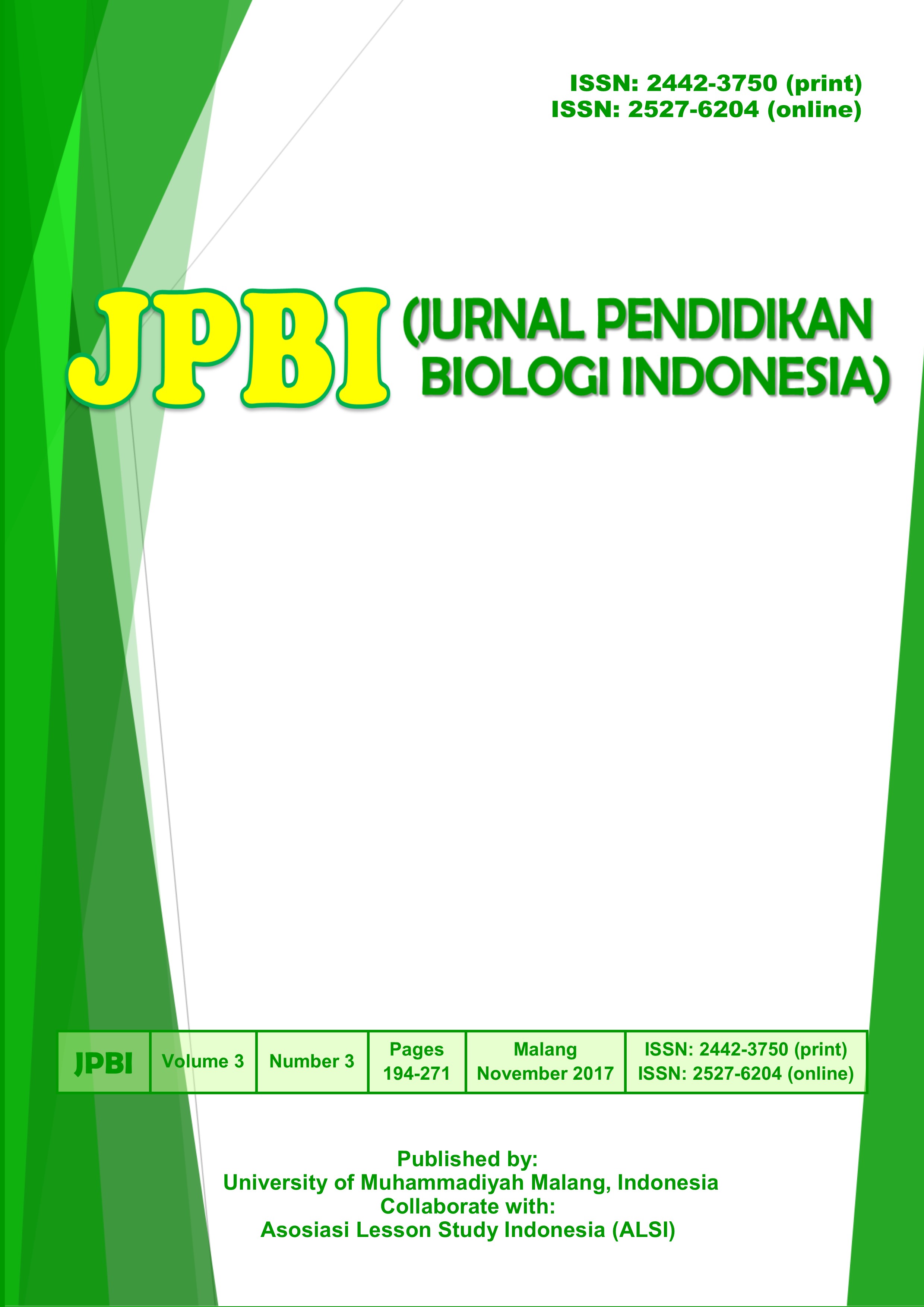The ability of quantitative literacy of pre-service biology students
DOI:
https://doi.org/10.22219/jpbi.v3i3.4874Keywords:
pre-service biology students, plant anatomy, quantitative indicators, quantitative literacyAbstract
This research have purpose to know and describe quantitative literacy of pre-service biology students based on six indicators of quantitative literacy. Methods used is descriptive with study survey. This research carried out at Siliwangi University with the subject as many as 30 pre-service biology students who take plant anatomy course. Based on the analysis of test and interview obtained that of 30 students, 4 students (13.3%) in high category, 10 students (33.3%) in medium category, and 16 students (53.3%) in low category. Overall, indicator of interpretation have succeeded owned by students, but other five indicators have not been owned. Lack of quantitative literacy of pre-service biology students is caused by course characteristics that tends to qualitative teaching materials that is not based on quantitative literacy, and inadequate facility to gain and analyzed quantitative data.
Downloads
References
AAC&U. (2011). Quantitative literacy value rubric. Hawaii: Association of American Colleges and Universities. Retrieved from https://www.google.co.id/url?sa=t&rct=j&q=&esrc=s&source=web&cd=3&cad=rja&uact=8&ved=0ahUKEwiJktaYqbTXAhUBlpQKHa5bBXAQFgg6MAI&url=https%3A%2F%2Fassessment.dasa.ncsu.edu%2Fwpcontent%2Fuploads%2Fsites%2F53%2F2015%2F09%2FQL-FinalRubric.pdf&usg=AOvVaw 1MPBGIdpWDA1MUOXO_rfCI.
Ardiansyah, R. (2014). Bahan ajar anatomi tumbuhan untuk menunjang literasi kuantitatif mahasiswa biologi. Prosiding Mathematics and Sciences Forum 2014, 411–416. Retrieved from http://prosiding.upgri smg.ac.id
Best, J. (2008). Beyond calculation: Quantitative literacy and critical thinking about public issues. (B. L. Madison & L. A. Steen, Eds.), The Mathematical Association of America (incorporated). United States of America: Mathematical Association of America. https://doi.org/http://dx.doi.org/ 10.5038/1936-4660.2.2.6
Cokely, E. T., Galesic, M., Schulz, E., Ghazal, S., & Garcia-Retamero, R. (2012). Measuring risk literacy: The berlin numeracy test. Judgment and Decision Making, 7(1), 25–47. Retrieved from http://journal.sjdm.org/11/ 11808/jdm11808.html
Hubert, D. a, & Lewis, K. J. (2014). A framework for general education assessment: assessing information literacy and quantitative literacy with eportfolios. International Journal of ePortfolio, 4(1), 61–71. Retrieved from https://www. google.co.id/url?sa=t&rct=j&q=&esrc=s&source=web&cd=1&cad=rja&uact=8&ved=0ahUKEwjFnfT8orTXAhULO7wKHQDUAa8QFggpMAA&url=http%3A%2F%2Fwww.theijep.com%2Fpdf%2FIJEP130.pdf&usg=AOvVaw07K4Enc0XtOat2P31ruJ4I
Lusardi, A., & Wallace, D. (2013). Financial literacy and quantitative reasoning in the high school and college classroom. Scholar Commons University of South Florida, 6(2), 1. https://doi.org/10.5038/1936-4660.6.2.1
McCright, A. M. (2012). Enhancing students’ scientific and quantitative literacies through an inquiry-based learning project on climate change. Journal of the Scholarship of Teaching and Learning, 12(4), 86–101. Retrieved from http://search.proquest.com/ docview/1314328364?accountid=13042
Mhakure, D. (2014). The contribution of course materials to a social justice agenda: Lessons from a quantitative literacy course for undergraduate social science students. Mediterranean Journal of Social Sciences, 5(23), 1190–1197. https://doi.org/10.59 01/mjss.2014.v5n23p1190
Nuraeni, E., Redjeki, S., & Rahmat, A. (2010). Perkembangan literasi kuantitatif mahasiswa biologi dalam perkuliahan anatomi tumbuhan berbasis dimensi belajar. Jurnal Ilmu Pendidikan, 21(2), 127–135. http://dx. doi.org/10.17977/jip. v21i2.5836
Responsibility, C. (2011). Value r. Retrieved August 3, 2017, from https://www. google.co.id/url?sa=t&rct=j&q=&esrc=s&source=web&cd=2&cad=rja&uact=8&ved=0ahUKEwjozpivlu_WAhUEpJQKHYjkCUoQFggtMAE&url=https%3A%2F%2Fmanoa.hawaii.edu%2Fassessment%2FMSC%2FQuantitativeLiteracy_VALUErubric.pdf&usg=AOvVaw3pnWhONFDBZoNkwIH9pGJp
Rhodes, T. L., & Finley, A. (2013). Using the value rubrics for improvement of learning and authentic assessment case study: University of north carolina wilmington use of aac&u value rubrics. (T. L. Rhoeds & A. Finley, Eds.). Washington DC: Association of American Colleges and Universities. Retrieved from https://www.eou.edu/ctl/ files/2012/10/E-VALRUBR2.pdf
Ricchezza, V. J., & Vacher, H. L. (2015). Review of developing quantitative literacy skills in history and the social sciences: A web-based common core approach by Kathleen W. Craver. Scholar Commons University of South Florida, 8(2), 1–9. https://doi.org/10.5038/1936-4660.8.2.14
Ricchezza, V. J., & Vacher, H. L. (2017). Quantitative literacy in the affective domain: Computational geology students’ reactions to devlin’s the math instinct. Scholar Commons University of South Florida, 10(2), 1–18. https://doi.org/ht tp://doi.org/10.5038/1936-4660.10.2.11
Stacey, K. (2015). The international Assessment of mathematical literacy: PISA 2012 framework and items. In S. J. Cho (Ed.), Selected Regular Lectures from the 12th International Congress on Mathematical Education (pp. 771–790). Cham: Springer International Publishing. https://doi.org/ 10.1007/978-3-319-17187-6_43.
Survani, R., Ardiansyah, R., & Nurqalbi, N. (2014). Kemampuan analisis informasi versus usaha mental mahasiswa dalam perkuliahan anatomi tumbuhan untuk menunjang literasi kuantitatif. Prosiding Mathematics and Sciences Forum 2014, 361–366. Retrieved from http://prosiding. upgrismg.ac.id.
Downloads
Published
Issue
Section
License
Authors who publish with JPBI (Jurnal Pendidikan Biologi Indonesia) agree to the following terms:
- For all articles published in JPBI, copyright is retained by the authors. Authors give permission to the publisher to announce the work with conditions. When the manuscript is accepted for publication, the authors agree to automatic transfer of the publishing right to the publisher.
- Authors retain copyright and grant the journal right of first publication with the work simultaneously licensed under a Creative Commons Attribution-ShareAlike 4.0 International License that allows others to share the work with an acknowledgment of the work's authorship and initial publication in this journal.
- Authors are able to enter into separate, additional contractual arrangements for the non-exclusive distribution of the journal's published version of the work (e.g., post it to an institutional repository or publish it in a book), with an acknowledgment of its initial publication in this journal.
- Authors are permitted and encouraged to post their work online (e.g., in institutional repositories or on their website) prior to and during the submission process, as it can lead to productive exchanges, as well as earlier and greater citation of published work (See The Effect of Open Access).

This work is licensed under a Creative Commons Attribution-ShareAlike 4.0 International License.


















